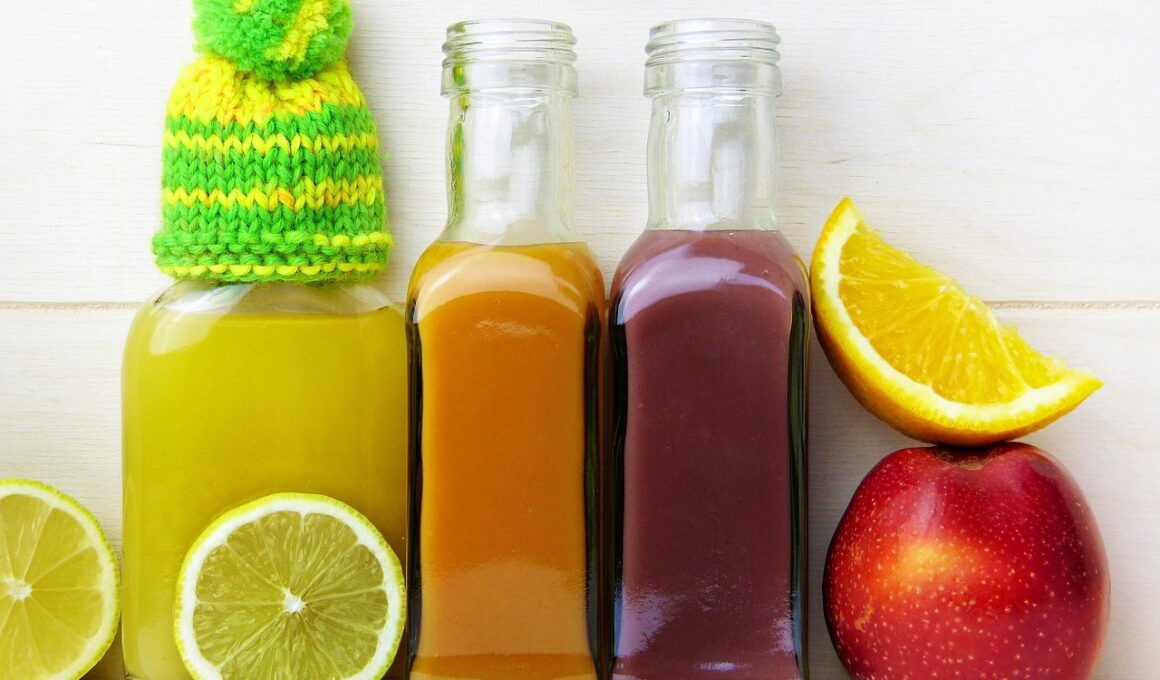Gluten-Free Detox Recipes for Sensitive Stomachs
If you have a sensitive stomach, detoxing can seem challenging yet rewarding. With the right approach, you can enjoy delicious gluten-free detox recipes. The goal is to incorporate ingredients that promote healing while avoiding gluten. By focusing on whole foods and natural ingredients, you can support your digestive health. Start your detox journey by incorporating fresh vegetables like spinach, kale, and carrots. They are packed with nutrients and beneficial enzymes that aid digestion. Additionally, fruits like apples and berries provide essential vitamins and serve as natural detoxifiers. Ensure your smoothies, salads, and soups contain a variety of colors to maximize nutrient intake. Quinoa and brown rice are excellent sources of gluten-free grains, providing energy without irritation. Moreover, include foods like ginger and lemon, which are known for their cleansing properties. As you experiment with recipes, be mindful of the balance of flavors while keeping it simple. The key is to create meals that are nourishing and satisfying, ensuring your detox journey is as enjoyable as it is beneficial for your health.
Benefits of a Gluten-Free Detox
There are numerous benefits associated with a gluten-free detox, especially for those with sensitive stomachs. Firstly, it helps in reducing inflammation, which can lead to various health issues. By removing gluten from your diet, you may notice improvements in digestion, leading to better nutrient absorption. This can awaken your energy levels, contributing to a feeling of overall wellness. Detoxing also allows your body to reset and remove toxins that can accumulate from processed foods. When following a gluten-free recipe plan, be sure to focus on fresh, organic foods. These not only help eliminate gluten but also provide essential nutrients necessary for healing. Incorporating foods rich in probiotics, like fermented vegetables, can support gut health and enhance digestion. You may explore unique flavors and recipes that showcase seasonal produce, which plays a significant role in a successful detox. Additionally, staying hydrated is crucial; consider herbal teas and infused water to keep your body cleansed. As an extra tip, listen to your body throughout the process, and adjust your meals according to your preferences and needs, ensuring a supportive detox experience.
When beginning your gluten-free detox journey, consider starting each day with a nourishing breakfast. A delightful smoothie bowl made with bananas, spinach, and almond milk can be a great start. Top it with gluten-free granola, chia seeds, and fresh berries for extra flavor and nutrients. These ingredients not only provide energy but also aid in digestion while being gentle on the stomach. Alternatively, oatmeal made from gluten-free oats can be a warm morning option. Prepare it with almond or coconut milk and add cinnamon for flavor. Include toppings like sliced apples, nuts, or seeds to enhance the taste and texture. For lunch, try a fresh salad incorporating avocados, cucumbers, and carrots, drizzled with lemon juice and olive oil. Both options are comforting and easily digestible, making them superb choices. Caution is key; avoid heavy dressings or processed toppings that might upset your stomach. Experiment with spices for flavor without the gluten, promoting both taste and aroma in your food. Remember, healthy meals don’t have to be boring; it’s about creative combinations that cater to your sensitivities while supporting detoxification.
Simple Gluten-Free Detox Recipes
Here are a few simple gluten-free detox recipes to add variety to your meal plan. Start with a refreshing cucumber and melon salad. Combine diced cucumbers, watermelon, and mint leaves, topped with a light lemon dressing for hydration and freshness. This is a highly digestible option. Another recipe is a wholesome quinoa salad. Mix cooked quinoa with black beans, peppers, and tomatoes. Drizzle with lime juice for a zesty kick. These ingredients offer healthy proteins and fiber while maintaining gluten-free integrity. You can also try stir-fried vegetables like broccoli, bell peppers, and zucchini with garlic and ginger, served over brown rice. Stir-frying keeps veggies crunchy and flavorful, combining easy digestion with vibrant colors. Incorporate a green smoothie, blending kale, apple, and avocado with coconut water. Such smoothies are nutrient-dense, refreshing, and perfect for detox days. Don’t forget a comforting soup on chilly days. A simple pureed butternut squash soup is creamy and naturally sweet, topped with a sprinkle of pumpkin seeds for added texture. With these recipes, your gluten-free detox can be both enjoyable and healthy.
Staying hydrated is important while detoxing. Adequate water intake will help flush out toxins from your body. Aim for at least eight glasses of water daily, and don’t forget about herbal teas. Chamomile tea is excellent for digestion, while peppermint tea can soothe stomach discomfort. Infuse water with lemon, cucumber, or berries to make it more exciting and flavorful. This can make hydration an enjoyable experience while providing additional nutrients. Herbal teas can also be beneficial during the detox process; they come in various flavors and can support your digestive system. As you progress through your detox, pay attention to how your body feels. Listen to its signals, such as energy levels or mood changes. Adjust your meals and snacks according to your body’s needs, allowing flexibility in your diet. You may discover new favorite dishes or tastes along your journey, which is part of the experience. Remember to eat slowly and mindfully as well; this can improve digestion and enjoyment of foods tremendously. Celebrate small victories in detoxing, recognizing the strides you make toward better health and understanding your dietary needs.
Tips for a Successful Detox
A few tips can help ensure your gluten-free detox is successful and rewarding. First, keep a food diary to monitor what you eat and how certain foods affect your stomach. This can help identify any triggers and make the detox process more effective. Each week, prepare a meal plan and grocery list to help streamline cooking and ensure you have all necessary ingredients on hand. Meal prepping on weekends can save time and reduce stress during the week. Allow flexibility within your detox; don’t be too strict if cravings hit. Instead, consider healthy alternatives that fit within your gluten-free parameters. For instance, if craving cookies, explore gluten-free versions using almond flour or oats. Additionally, enlist the help of friends or family for support. Share your journey and perhaps inspire them to join in; cooking together can be productive and fun! Explore local resources for gluten-free recipes or cooking classes as well. Finally, remember that detoxing shouldn’t feel punishing; prioritize nourishment over restriction. Embrace the process, finding joy in discovering delicious gluten-free options.
In conclusion, detoxing while maintaining a gluten-free diet can be both rewarding and enjoyable. With a focus on whole, natural ingredients and mindful preparation, you can create satisfying meals that support your health. The importance of listening to your body cannot be overstated. Every individual may have unique responses to different foods. Therefore, adapt your recipes and meals to what makes you feel best. As you navigate through your detox, remember that the ultimate goal is to cleanse and nourish your body. Fueling yourself with nutrient-rich foods will lead to improved energy and overall well-being. Keep exploring new recipes, flavors, and ingredients, as you may discover enjoyable surprises along the way. Remember to take it slow; detoxing is not a race, but rather a journey towards enhanced vitality. Utilize online resources or recipe books for additional inspiration and ideas. Share your experiences and favorite detox recipes with friends and family. They could benefit from your journey towards healthier eating. Embrace this process of discovery and improvement—it’s about creating lasting lifestyle changes that benefit you and your sensitive stomach.
Your Path to Better Health
Embarking on a gluten-free detox can lead to improved health and well-being. As you incorporate more nutritious, wholesome foods and eliminate gluten from your diet, notice the changes in your body and digestion. Embrace this opportunity not only as a cleaning phase but also as a way to foster a healthier relationship with food. Make tracking your progress enjoyable! Try new recipes, experiment with substitutions, and enjoy the vibrant colors in your meals. By focusing on natural ingredients, you are setting a solid foundation for your health moving forward. Explore farmers’ markets or local organic stores to find fresh produce. Quality ingredients make a significant difference in flavor and nutrition, contributing to a more successful detox. Above all, acknowledge that you’re not alone on this journey. Connect with communities online or attend local workshops to engage with others exploring similar paths. Support system and shared experiences can be encouraging. Approach your gluten-free detox with curiosity and openness. You’ll unlock various healthy delights that make the journey as delectable as the final results. Your sensitive stomach may thank you for the care and attention you give it through this process.


